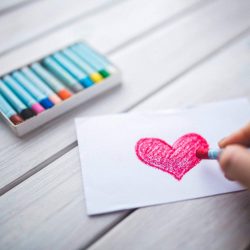Emotional burnout is a term we are hearing more often. With so many external stressors, expectations and demands, we can find ourselves working toward emotional burnout. The good news is that it is both avoidable and treatable. There are many ways to nourish ourselves and support our wellbeing. We also have more options today to work through burnout. Some options, such as art therapy, tap into our creativity to help us through the healing. We spoke with Sharon Itkoff Nacache, a psychotherapist specializing in Art Therapy to learn more.
Meet Sharon
Sharon: My name is Sharon Itkoff Nacache. I’m a licensed and board certified creative arts therapist, and I manage a group art therapy practice based in New York City and also online called the Art Therapy Practice.
What is emotional burnout?
Sharon: It’s a really common kind of buzzword. People talk about, “Oh, I feel so burnt out. Oh, I’m burning out,” but it’s actually a clinical term that was developed in the ’70s by a psychologist named Freudenberger. He originally applied it to kind of professional settings, and it had to do with feeling really stressed out chronically and underappreciated on the job. But we’re also seeing it in our everyday lives, especially now because our homes and our workplaces are fused. And it really is this mental health reaction to being under chronic stress without respite, without addressing it.
And it can look a lot of ways. It can look like depression. It can look like chronic fatigue. It can look like hyperreactivity. I know we talked in the art section about it’s almost like anything sets you off, especially those you love the most. So it’s disproportionate, right? It’s like you target the ones that you feel the most around because you no longer have those emotional regulation restraint skills because you’re burned out, and it can also affect motivation. It can kind of go in the opposite direction in terms of feeling like just detached, like forget about it. I can’t even do anything. So it’s a whole spectrum of burnout, and I think that people don’t really understand that it’s a clinical symptom. It’s not necessarily depression, and it’s also treatable.
How do you know if you are on your way to emotional burnout?
Sharon: I think a lot of it is around self-knowledge, right, and first tuning into what are my own warning signs. If I find myself starting to get hyper-reactive, I know, okay, I need to take a step back. So I think first is kind of the checking in with ourselves, and I think starting to put boundaries around our time and our space, if at all possible. When we are at home with our kids and managing a job and dealing with all of these demands, it’s really hard to do that.
But I think, however, you can create that head space and that separation, whether it’s listening to music while you’re cooking, going for a quick jog after bedtime, maybe taking some time to journal or do some quick scribbling if you’re on a call, I think anything you can do as like small self-care acts that you can kind of slip into your everyday life really helps and taking breaks, which I know is easier said than done.
What do you do if you are there?
Karolina: It’s that sense of overwhelm, and it’s there all the time. What do you do if you’re there?
Sharon: It’s almost like you’re running on empty and that’s when we get in survival mode. We’re not at our best, and we’re just trying to get by. So I think being self-compassionate would be the first step, not beating ourselves up around it and being we should be doing better, should be doing more. Recognizing this means… This is actually when we need more TLC, more tender, love and care, more support, right? So that’s the hard one, but I think self-compassion is really the first step when you’re feeling really burnt out and then taking a break.
I know I talked about this, but if there’s a way to take ideally a day off from a project you’re working on, clearly not with childcare, but some separation, having someone else manage the kids for a little while while you get a breather and do something good for yourself. I think that those are just small ways that you can start to kind of get back your balance.
What is Art Therapy?
So Art therapy is an integrative mental health field and it combines elements of developmental psychology with art making, and that’s all within the context of a therapeutic relationship. So for some people that looks like art as therapy, which is a little bit what we did last week of just kind of the kinesthetic release of splatter painting or scribbling, and it just feels good just to make it, right?
And then for other people that looks like art psychotherapy, which means they’ll make something or we’ll make something together and they’ll start to symbolize and interpret and kind of create meaning based on whatever they’ve created. It’s kind of a projective technique. And then there’s something called open studio, which is more of a guided format, which is self-reflection and a little bit of stepping back just to kind of encourage that mindful art making process. So that there’s different ways to do art therapy and it looks different with everyone, but the common thread is that art making and creativity is inherently healing because words aren’t always enough.
It can’t always describe or help express when we feel backlogged with emotion or if we’ve been traumatized or if we are too overwhelmed to start to articulate with that part of our brain.
Why is Art Therapy emotionally supportive?
Karolina: So what is it about art that helps sustain emotions and help sustain our mental health that words cannot do?
Sharon: Great question. It’s a big question. Art the way we process as humans is we function in images, right? Our memory works in images, so that’s how we store our earliest memories. That’s also how we store trauma experiences. And we learn to express our experiences in usually creative ways, movement, art making, thinking about little kids, right, before we have words. Words are the language left brain part of our brains, right? And creativity is in the right side. And I think that when it comes to certain experiences that haven’t yet been integrated, and that’s often when there is trauma or something that has become too overwhelming to make sense of, that’s where the art process comes in. It’s this additional tool to help express and externalize whatever it is.
Meet Sharon Itkoff Nacache



